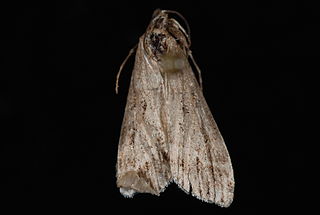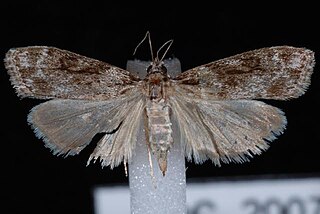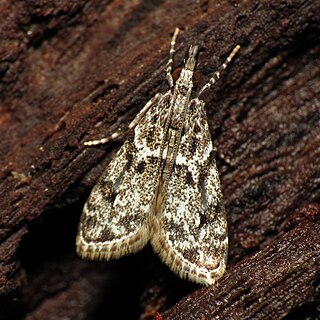
Eudonia philerga is a species of moth of the family Crambidae. This species was first described by Edward Meyrick. It is endemic to New Zealand and is found throughout the country. E. philerga is regarded as being common. Larvae feed on moss and the adults have been observed on the wing more frequently from October to April. Adult moths are attracted to light.

Eudonia echo is a moth of the family Crambidae described by Harrison Gray Dyar Jr. in 1929. It is found in western North America from British Columbia to California.

Eudonia murana, the Scotch gray or wall grey, is a moth of the family Crambidae. It was described by John Curtis in 1827 and is found in most of Europe.

Eudonia pallida is a species of moth of the family Crambidae. It was described by John Curtis in 1827 and is known from most of Europe. Its alternative name is the Marsh Grey.

Eudonia bisinualis is a species of moth in the family Crambidae. It was described by George Vernon Hudson in 1928. This species is endemic to New Zealand.

Eudonia angustea is a moth of the family Crambidae described by John Curtis in 1827. It is found in southern and western Europe, the Canary Islands, Madeira and Turkey.

Eudonia alpina is a species of moth in the family Crambidae. It is found in Great Britain, Fennoscandia, Estonia, Russia, Japan and North America, including Alaska, Alberta, Newfoundland, Minnesota, Ohio and West Virginia.

Eudonia laetella is a species of moth in the family Crambidae described by Philipp Christoph Zeller in 1846. It is found in Fennoscandia, the Baltic region, Belarus, Russia, Poland, the Czech Republic, Slovakia, Hungary, Romania, Bosnia and Herzegovina, the Republic of Macedonia, Greece, Slovenia, Austria, Switzerland, Italy, Germany and Belgium.

Eudonia lineola is a species of moth in the family Crambidae. It is found in Great Britain, Ireland, the Netherlands, France, Spain, Portugal and on Sardinia, the Canary Islands, as well as in North Africa, including Morocco.

Scoparia illota is a species of moth in the family Crambidae. It is endemic to New Zealand. The larvae of this species are leaf miners.

Eudonia asterisca is a moth in the family Crambidae. It was named by Edward Meyrick in 1884 and is endemic to New Zealand. It has been recorded in both the North and South Islands. This species is recorded as being present at sea level up to altitudes of 1350 m. This species has been recorded as inhabiting native podocarp/hardwood forests. The adults of this species are on the wing from December until March although they have also been recorded in October and November. They are attracted to light and have also been trapped via sugar traps.

Eudonia zophochlaena is a moth in the family Crambidae. It was described by Edward Meyrick in 1923. It is endemic to New Zealand. It has been hypothesised that this species is a North Island endemic. The adults of this species are on the wing from December until February. The larvae of this species are leaf miners of the leather-leaf fern Pyrrosia eleagnifolia.

Eudonia commortalis is a moth in the family Crambidae. It was described by Harrison Gray Dyar Jr. in 1921. It is found in North America, where it has been recorded from Alaska to British Columbia, Washington and California.

Eudonia leucophthalma is a moth in the family Crambidae. It was described by Harrison Gray Dyar Jr. in 1929. It is found in North America, where it has been recorded from British Columbia and Alberta to Washington and California.
Eudonia expallidalis is a moth in the family Crambidae. It was described by Harrison Gray Dyar Jr. in 1906. It is found in North America, where it has been recorded from Washington to Nevada and California.

Eudonia spenceri is a moth in the family Crambidae. It was described by Eugene G. Munroe in 1972. It is found in North America, where it has been recorded from California and Arizona to Montana and British Columbia.

Eudonia heterosalis is a moth in the family Crambidae. It was described by James Halliday McDunnough in 1961. It is found in North America, where it has been recorded from Nova Scotia to Ontario and southern Quebec, south to Louisiana and Florida.
Eudonia rectilinea is a moth in the family Crambidae. It was described by Zeller in 1874. It is found in North America, where it has been recorded from British Columbia, California, Montana, Nevada, Oregon and Washington.
Eudonia schwarzalis is a moth in the family Crambidae. It was described by Harrison Gray Dyar Jr. in 1906. It is found in North America, where it has been recorded from Arizona.

Eudonia spaldingalis is a moth in the family Crambidae. It was described by William Barnes and James Halliday McDunnough in 1912. It is found in North America, where it has been recorded from Alberta, Arizona, British Columbia, California, Colorado, Montana, Nevada, New Mexico, Utah and Wyoming.
















